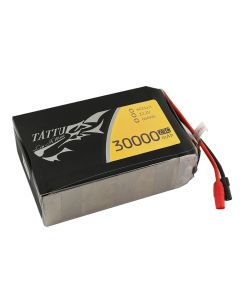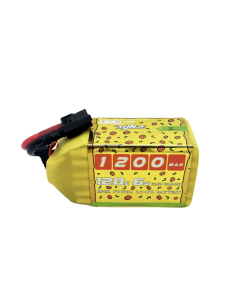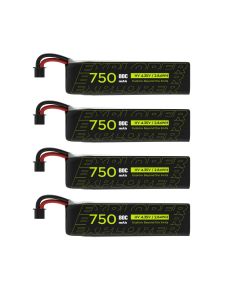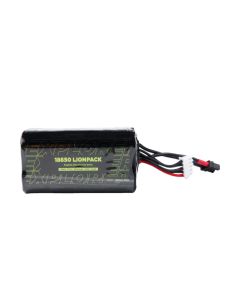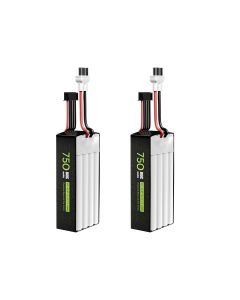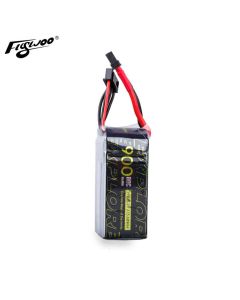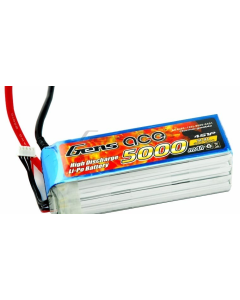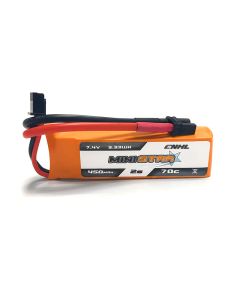Gens ace 2S 7.4V 5000mAh 50C Lipo Battery with XT60 Plug
Additional Information
| Brand | Gens ace |
| Capacity(mAh) | 5000 |
| Voltage(V) | 7.4 |
| Discharge Rate (C) | 50 |
| Max Burst discharge Rate (C) | 100 |
| Configuration | 2S1P |
| Net Weight(±20g) | 265 |
| Length(±5mm) | 135 |
| Width(±2mm) | 42 |
| Height(±2mm) | 21 |
| Wire Gauge | 12# |
| Discharge Wire Length(mm) | 120 |
| Balancer Connector Type | JST-XHR |
| Balancer Wire Length(mm) | No |
Lipo Battery Guide
What's a Lipo battery?
Lipo Battery, its full name is lithium polymer battery, people also called Li-po battery, or more correctly lithium-ion polymer battery (abbreviated as LiPo, LIP, Li-poly and others). Lipo is a rechargeable battery of lithium-ion technology using a polymer electrolyte instead of a liquid one. High conductivity semisolid polymers form this electrolyte. These lipo batteries provide a higher specific energy than other lithium-battery types. It is a newer type of battery now used in many consumer electronics devices. They have been gaining in popularity in the radio control industry over the last few years, and are now the most popular choice for anyone looking for long run times and high power.
LiPo batteries offer a wide array of benefits. But each user must decide if the benefits outweigh the drawbacks. For more and more people, they do. In my personal opinion, there is nothing to fear from LiPo batteries, so long as you follow the rules and treat the batteries with the respect they deserve.
This guide is mainly to introduce the basic Lipo battery knowledge about Lipo Battery Parameters, Lipo battery’s choice, Lipo battery’s maintenance, Lipo battery’s safe and Gens Ace Tattu Lipo battery’s Service.
Lipo Battery Parameters Introduction
We can see there are some Parameters on this Lipo battery, they are Battery Capacity, Battery Voltage, Cell Configuration and Discharge Rate, our guide will introduce what are these parameters stand for?
- Discharge Rating
- Cell Configuration
- Battery Voltage
- Battery Capacity
- top
Cell Configuration
A battery is constructed from rectangular cells which are connected together to form the battery. A cell which can be considered a battery in itself, holds a nominal voltage of 3.7V. By connecting more of these in series, the voltage can increase to 7.4V for a 2 cell battery, 14.8V for a 4 cell battery and so on. By connecting more batteries in parallel the capacity can be increased. Often you will see numbers like 3S2P, which mean the battery as 4 cells (4S) connected in series, and there are 2 cell sets connected in parallel (2P) , giving a total number of 6 individual sells in the battery. So the number of cells is what defines the voltage of the battery. Having a higher voltage means the battery can provide more power to drive bigger motors, however more power does not necessarily mean the battery will provide energy for longer, that is defined by the battery capacity.
Battery Voltage
A LiPo cell has a nominal voltage of 3.7V, and a lipo cell = 1 cell = 1S = 3.7V. For the 14.8V battery above, that means that there are four cells in series (which means the voltage gets added together). This is sometimes why you will hear people talk about a “4S” battery pack – it means that there are 4 cells in Series. So a four-cell (4S) pack is 14.8V, a three-cell (3S) pack is 11.1V, and so on.
3.7V battery = 1 cell x 3.7V= 1S battery7.4V battery = 2 cells x 3.7V= 2S battery
11.1V battery = 3 cells x 3.7V= 3S battery
14.8V battery = 4 cells x 3.7V= 4S battery
18.5V battery = 5 cells x 3.7V= 5S battery
22.2 V battery = 6 cells x 3.7V= 6S battery
29.6 V battery = 8 cells x 3.7V= 8S battery
37.0V battery = 10 cells x 3.7V= 10S battery
44.4V battery = 12 cells x 3.7V= 12S battery
The voltage of a Lipo battery pack is essentially going to determine how fast your vehicle is going to go. Voltage directly influences the RPM of the electric motor (brushless motors are rated by kV, which means ‘RPM per Volt’). So if you have a brushless motor with a rating of 3,500kV, that motor will spin 3,500 RPM for every volt you apply to it. On a 2S LiPo battery, that motor will spin around 25,900 RPM. On a 3S, it will spin a whopping 38,850 RPM. So the more voltage you have, the faster you’re going to go.
When you select lipo battery, you need to know your motor of rc model, Voltage has an impact on motor, and motor influence the speed. The higher voltage is, the higher power( P) of the motor is, and here is the formula:
P=U*I
“P” is power, “U” is voltage, “I” is current. As you know, the voltage influence the power of the motor of battery, and the power has an impact on the RPM of the motor, that means speed. So in some racing, pilots need the batteries are of high voltage to meet the needs of their rc model to get a high burst.
Battery Capacity
The 1300mAh on the picture means the capacity of the lipo battery. Capacity is used to measure how much power a battery can hold.and the unit of capacity is milliamp hours (mAh), which means 1300mAh can be put on the battery to discharge it in one hour. Milliamp also can be converted to amps(A), here is the conversion:
1300mAh=1.3 Amp Hour(1Ah)
Generally, capacity can determines how long you can run before you have to recharge. A larger capacity pack may give you longer flight times but being heavier it will adversely affect performance. But it`s also influenced by the speed, the more quick you can flying your plane, the less time your flight time is. Because high speed means you need more power to drive your plane or others, so your power lost quickly.
Discharge Rating
Discharge Rate ("C" Rating) is simply how fast a battery can be discharged safely. In the RC LiPo battery world it is called the “C” rating. A battery with a discharging rate of 95c, that means you could safely draw it at the 95 times more than the capacity of the pack, a 10C pack = 10 times more, a 20C pack = 20C times more, from above the picture, you can discharge at 95 times more than 1300mAh, here is the calculation below:
95C = 95 x Capacity (in Amps)=95*1300mAh=123500mAh=123.5Ah
From the theoretical stand point, if you discharge you battery at a 2600mAh, so the 1300mAh of battery pack can be exhausted in half an hour. From above the calculation, draw battery at 123.5Ah, so this battery pack will be draw out in 0.63 minutes.
Sometime, you would be required to get a battery of high discharging rate, usually in a race, such as FPV racing, you must in a high speed and win a race. So the higher “C” rating means your thing can get a higher burst in a moment. So, you know, why so many pilots attach such a great importance into the high discharge rate. But the disadvantage of the high “C” rating is it may get heavier and affect its performance. And it may more expensive than the lower one.
Our Lipo batteries are mainly used for RC hobbies, like RC cars, Drone/UAV, RC Airplane/Heli and FPV. In order to get the best flight or running time and performance it important to know how to go about choosing the best Lipo battery.
Like most components on a drone or car, they are related to other components, and the battery is no exception. The correct battery mainly depends on the size of your drone or car, and the type and number of motors you use. In this guide we will discuss how to ensure your battery will work properly with your drone or car system before you buy it.
Knowing what size battery you need
To get the longest flight or running times you should use the largest battery (in terms of capacity) that you possibly can(but still keep within the maximum takeoff weight of your drone). The other thing to take into account is the physical size of the battery, as depending on what drone or car you are using you will only need be able to fit a battery of a certain size.
Battery Discharge Rate and Capacity
Probably the most important, but often overlooked factor to is the check the battery discharge C rating is the optimum for your drone or car. Using a discharge rate (C rating) that is too low, can result in your battery being damaged, and your drone or car under-performing the battery cant release current fast enough to power your motors properly. Since higher C rating batteries are heavier, if the battery you are using has a C rating that is too high, you will just be carrying extra weight around that you dont need, ultimately reducing the running time.
How to calculate the maximum continuous current output for your battery
In order to know what the total current draw of your drone system is, we cab calculated it based on this simple formula:
Max continous Amp draw (A)= Battery capacity (Ah) x Discharge rate (C)
For a example, we have a 5100mAh 3 cell Lipo battery with a 10C rating. To find the maximum continuous amp draw, we first convert the 5100mAh to 5.1Ah, and multiply that number by 10C, to give a total continuous output of (5.1 x 10) = 51A
How to find the optimum C rating
As choosing the battery is often the last step to building your own drone, we will already know what motors and ESC we are using. Since the motors will draw the most amount of energy from your battery we can base our calculation around this.
The battery C rating depends on the capacity
There is no fixed C rating that you will need to use as the maximum current output of a battery depends on the capacity and C rating. Typically the smaller the capacity of a battery, the higher the C rating needs to be, this is why for many high capacity multi-rotor batteries you will find very low C ratings in the range of 10-15C.
How much capacity do I need?
Now that you know the required current draw from your battery, the capacity and C rating can be found. In general its best to get teh highest possible capacity battery that you can, which still keeping the total weight of your quadcopter including the battery and other equipment at aroung 50-70% of the maximum motor thrust.
So sticking to our quadcopter example, we know that 50% thrust is around 500g per motor (or 2Kg thrust in total). Our frame, electronics and motors weight come to 1.2Kg. That leaves 800-1000g that we can use for the battery. So you should try to find the highest capacity LiPo that you can find that weights less than this.
Battery Voltage
The battery voltage, or cell count is another important decision that you will need to make. Higher voltage batteries allow your motors to produce more power, however the higher voltage batteries are heavier since they contain more cells.
There is no golden rule to follow when it comes to battery voltage, but the way you can find the best voltage for your drone is to look through your motor thrust data tables and compare the efficiency. You will find that motors are generally more efficient and powerful when using higher cell count lipos (higher voltage), but some of the efficiency bonus is negated by the increase in weight and cost of the battery. So depending on how many motors you are using you will need to choose what is best for your current setup.
One thing to bear in mind is to also make sure that your motors/ESC and other electronics are able to support the voltage of your battery. Some motors will only support a specific cell count lipo, or a specific range of voltages which might make the decision easier.
Battery Connectors
Soldering battery connectors can be a real pain, so it is a good idea to try find a battery connector that you like, and stick to it. That allows you to swap batteries easily, and if you decide to build another drone in the future you can use the same batteries. Common connectors include Deans/Tplug, XT60, and also EC3 connectors.
Number of batteries
The number of batteries you decide to use on your drone does not ultimately make much difference as there are pros and cons of using more batteries. Firstly using more batteries has an added layer of safety as if one battery should fail, you still have another that you can use to quickly land. Also if you have the flexibility of replacing one battery if one of them gets older than the other. Charging time can be reduced if you have two chargers as each one can charge at the same time. However using two batteries can be more complex to mount and wire and buying two batteries can sometimes be more expensive than buying one. So ultimately using one ore more batteries comes down to the drone your are using and your own preference.
After read this guide, you may know how to choose Lipo battery, our website recommend you some Lipo battery, if you need to buy Lipo batteries, you can have a look.
Before Charge
- Please read the charger instruction book before charging.
- Always check the voltage of Batteries before each charge session in order to ensure they are at or above the minimum safe starting voltage. If starting voltage is below recommended levels then Batteries have been over discharged or have experienced a failure and should NOT be charged.
- Always check the battery before charging for any type of damage. Check the battery packaging, wires and connectors for defects, which may cause a short circuit and eventual battery failure.
- Make sure you are using charge leads which are compatible with the battery connectors.
- User should check the polarity of the battery cable and charger lead carefully before the connection to avoid any short circuit.
- Always verify the charger is in good condition. A poor quality charger can be dangerous.
It is solely your responsibility to assure that the charger you use works properly. Always monitor the charging process to assure batteries are being charged properly. Failure to do so may result in a fire.
Charging
- Only use charger designed for lithium polymer/Lion battery. Do not use a NIMH/ NICD/ LIFEPO4/ LEAD ACID charger. If the charger can support different battery types. Be absolutely sure to select the Lithium polymer (Lipo) mode on the charger. Failure to do so may cause a fire, which may result in personal injury and property damage.
- User should Always charge Batteries in an open area away from flammable materials, liquids and surfaces.
- Never charge Batteries inside of the model.
- Never charge batteries below freezing (0°C, 32°F)
- Never charge Batteries that are hot to the touch (above 100° F). DO NOT handle Batteries until they are cool.
- User should Always set the charger to the proper cell count and/or voltage listed on Batteries’ labels.
- User should Always set the charger to the amp charge rate as listed on Batteries’ labels.
The charger should never be set to charge Batteries at a rate greater than 1C (One (1) times the capacity of Batteries in amp hours) unless another C rate is specified in the manufacturer’s product documentation or the rate is preset as part of a specific battery and charger combination. DO NOT alter the charge rate once charging has begun.
- Never overcharge Batteries beyond the capacity listed on Batteries’ labels.
- Never overcharge batteries over their rated maximal voltage (4.2V/cell for LiPo).
- It must choose series charging if two or more battery packs be connected in series for using.
- Use suitable and good quality chargers, please don’t use cheap and low quality chargers, use the professional Lithium polymer charger to charge the Gens ace & Tattu battery. When charging, please make sure the surroundings is clean, without sundries around. Don’t charge without monitoring. Using lipo sack is suggested when charging to ensure the charging safety. Stop charging timely when the battery is fully charged. Do not connect the charger and the battery for a long time when the battery is fully charged. We will not be responsible for any personal in jury and property lost or any kind accident that caused by improper charging.
Discharging
Never discharge Batteries at amperage rates higher than specified on Batteries’ labels.
Never allow the temperature of Batteries to exceed 140°F during discharge. Adequate cooling for Batteries is required, especially when discharging at or near maximum rates.
Never discharge Batteries to voltage below which they are rated by the manufacturer when measured under load(connected to the vehicle or a charger capable of discharge). Batteries discharged to a voltage lower than the lowest approved voltage may be damaged, resulting in loss of performance and potential fire when Batteries are charged.
Never discharge battery to a level below 3V per cell under load. For Tattu series batteries which are used for Unmanned Aircraft System, The recommended cut off voltage is 3.5V per cell.
Never leave battery unattended during the discharging process. During the discharging process, user should monitor the process constantly and react to potential problem that may occur.
In case of emergency, discontinue the process immediately, disconnect the battery, place it in a safe area, and observe it for approximately one hour. This may cause the battery to leak and the reaction with air may cause the chemicals to ignite, resulting in a fire. A safe area should be outside of any building or vehicle and away from any combustible materials. A battery can still ignite even after one hour.
User need to check the conditions of the battery before use it or discharge it. Stop using it if user found the cells are not balanced or cells are puffing or weeping.
Lipo Battery Storage:
- Do not directly connect the terminals with metal objects. This will short-circuit Batteries, resulting in heat and electrical discharge.
- Never store loose Batteries together, the Batteries’ terminals may contact one another causing a short circuit.
- Never storage Batteries to extreme temperatures or direct sunlight. The battery should be stored within -10℃ ~ 45℃ range environmental condition. If the battery has to be stored for a long time (Over 3 months), the environmental condition should be:
Temperature: 23±5℃
Humidity: 65±20%RH
The voltage for a long time storage should be 3.6V~3.9V range per cell.
- Always disconnect Batteries when not in use and store Batteries in a non-conductive and fireproof container.
- Never alter, puncture or impact Batteries or related components.
Damage Limits
Rcmumbai will not be liable for special, indirect or consequential damages, loss of profits or production or commercial loss in any way connected with the product,
whether claim is based in contract, warranty, negligence, or strict liability. Further, in no event shall the liability of Rcmumbai exceed the individual price of the product on which liability is asserted. As Rcmumbai has no control over use, setup, final assembly, modification or misuse, no liability shall be assumed nor accepted for any resulting damage or injury.
By the act of use, setup or assembly the user accepts all resulting liability.
If you as the purchaser or user are not prepared to accept the liability associated with the use of this product, you are advised to return this product immediately in new and unused condition to the place of purchase.
Instructions For Disposal By Users
This product must not be disposed of with other waste. Instead, it is the user’s responsibility to dispose of their waste equipment by handing it over to a designated collection point for the recycling of waste electrical and electronic equipment.
The separate collection and recycling of your waste equipment at the time of disposal will help to conserve natural resources and ensure that it is recycled in a manner that protects human health and the environment. For more information about where you can drop off your waste equipment for recycling, please contact your local city office, your household waste disposal service or where you purchased the product.
The user have to read the above instructions carefully before buy the Gensace & Tattu Lithium polymer battery. If the user act against the instructions cause any problem, Gens ace & Tattu won’t take responsibility for that.
Lipo Battery Safety
Health and Safety warning
- Reverse charging is prohibited. The cell shall be connected correctly. The polarity has to be confirmed before wiring, In case of the cell is connected improperly, the cell cannot be charged. Simultaneously, the reverse charging may cause damaging to the cell which may lead to degradation of cell performance and damage the cell safety, and could cause heat generation or Leakage.
- Never strike battery with any sharp edge parts
- Trim your nail or wear glove before taking battery
- Never open or deform folding edge of the cell
- Never Fall, hit, bend battery body
- Never disassemble the cells. The disassembling may generate internal short circuit in the cell, which may cause gassing, firing, or other problems
- LIPO battery should not have liquid from electrolyte flowing, but in case the electrolyte come into contact with the skin, or eyes, physicians shall flush the electrolyte immediately with fresh water and medical advice is to be sought.
- Never incinerate nor dispose the cells in fire. These may cause firing of the cells, which is very dangerous and is prohibited. The cells shall never be soaked with liquids such as water, seawater drinks such as soft drinks, juices coffee or others.
- The battery replacement shall be done only by either cells supplier or device supplier and never be done by the user.
The cells might be damaged during shipping by shock. If any abnormal features of the cells are found such as damages in a plastic envelop of the cell, deformation of the cell package, smelling of electrolyte, electrolyte leakage and others, the cells shall never be used any more.
The cells with a smell of the electrolyte or a leakage shall be placed away from fire to avoid firing.
Noticed: If at any time the battery becomes damaged, hot, begins to balloon or swell, discontinue charging or discharging immediately. Quickly and safely disconnect the battery from the charger or model. Then place the battery and/or charger in a safe, open area,away from flammable materials inside a fireproof container (such as a LiPo safety bag). After one hour, if the battery condition has stabilized, remove the battery from service. Do not continue to handle, attempt to use, or ship the battery. Failure to follow these procedures can cause damage to the battery, personal property or cause serious injury.
| C Rating | 50 |
|---|---|
| Battery Voltage | 2S 7.4V |
| Battery Capacity | 2501 - 5000mAh |
| Brand | GENS ACE |





